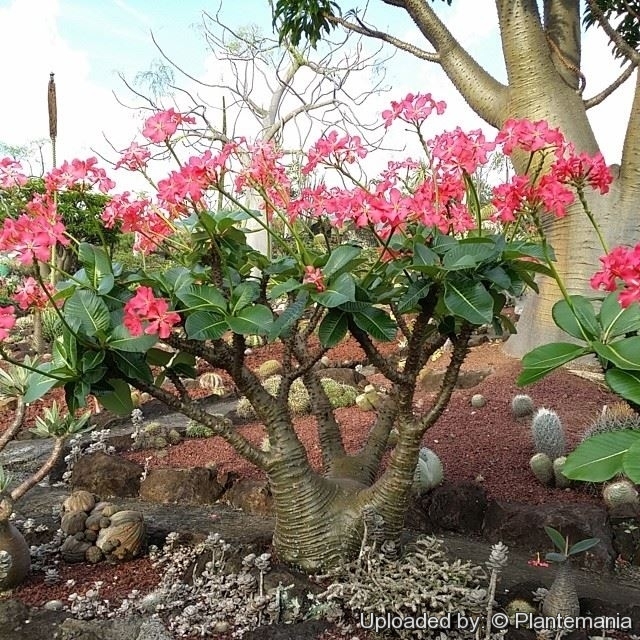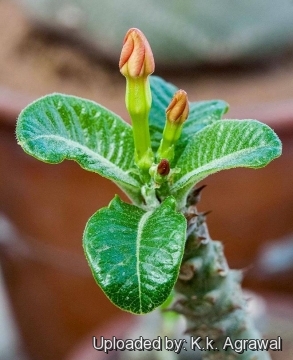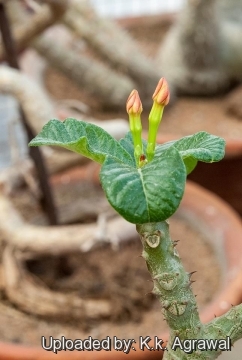Accepted Scientific Name: Pachypodium baronii subs. windsorii (Poiss.) Pichon
Mém. Inst. Sci. Madagascar, Sér. B, Biol. Vég. 2: 123 (1949)

Pachypodium windsorii (Pachypodium baronii subs. windsorii) Photo by: © Plantemania
Origin and Habitat: Extreme north of Madagascar. For a long time, it was only known to occur in the Windsor Castle massif but, in 2005, two new subpopulations were discovered at the Beantely massif and Amboaizamikono massif.
Altitude range: 270-390 metres above sea level.
Habitat and ecology: Plants grow on steep calcareous outcrops or step slopes in full sun or in open dry forest or wooded grassland in light shade. It is threatened by forest logging and fire. The habitat is also impacted by exploitation of residual forests for timber and fuel.
Synonyms:
See all synonyms of Pachypodium baronii
back
Accepted name in llifle Database:Pachypodium baronii Costantin & BoisAnn. Sci. Nat., Bot. IX, 6: 317 (1907)Synonymy: 3
Accepted name in llifle Database:Pachypodium baronii subs. windsorii (Poiss.) PichonMém. Inst. Sci. Madagascar, Sér. B, Biol. Vég. 2: 123 (1949)Synonymy: 2
back
Common Names include:
ENGLISH: Windsor's Elephant's Foot
CHINESE (中文): 溫莎瓶幹
LITHUANIAN (Lietuvių): Karpažolinis tukvis
Description: Pachypodium baroniiSN|14804]]SN|14804]] subs. windsorii is a remarkable caudiciform plant, 0.50-1.50 m high, with a grotesquely swollen, flask-shaped trunk that gives rise to several slender, twisting, mildly spiny branches, each of which carries a sparse crown of simple leaves. It is a local or morphological form of Pachypodium baroniiSN|14804]]SN|14804]] smaller in all parts, but commonly used to be know as a separate species and very popular with 'fat plant' collectors. The showy trumpet-shaped red flowers also held on much shorter peduncles. It is the only red-flowered member of the genus.
Trunk: Caudiciform globose or bottle-shaped subglobose or ovoid 30-50 tall, 35-60 cm in diameter. Bark grey or grey-green, smooth or with leaf scars.
Branches: 1-5 from the apex or the side of the trunk, swollen at the base, 10-80 cm long, 1.5-3 cm in diameter no branched with few branchlets 7-13 mm across.
Prickles: Paired straight or slightly curved, broadly conical and laterally compressed, 2-6 mm long puberulent with red apex when immature, turning glabrous and less sharp.
Leves: Thick, subcoriaceous, papery when dried, subsessile in a whorled tuft on branch tips ovate to elliptic 3-11 cm long 2.7-7 cm broad rounded or stif at the apex, apiculate, wedge shaped or rounded at the base. Petiole 2-10 mm long, 2-5 mm in diameter, pubescent. Deep green, bullate, glossy, with a pale green or yellowish midvein and secondary veins and tertiary venation reticulately impressed above, pale glaucous with darker venation beneath Completely deciduous in winter .
Inflorescence: Dense 6-13 long and 2-6.7 cm broad. 3-7-flowered. Peduncle al-most undeveloped 12-80 mm long hairy or hairless. Pedicels short, 3-5 mm long, sparsely hairy. Bracts ovate, 2-2.5 mm long.
Flowers: Red with a pale-green eye in the centre ca. 50 mm in diameter. Sepals pale green ovate 2-3 mm long, obtuse to acuminate at the apex. Petals pale red to crimson, Throat reddish-green and basal part pale green and with yellow or pale green star inside surrounded by dark red in the throat. Stamens exerted 3-5 mm below the mouth of the corolla tube, anthers very narrowly triangular just below where they cohere with the pistil head. Pistil 18-20 mm long. Style 15-17 mm long, pistil head 1 mm high.
Blooming season: It flowers profusely in spring (in habitat flowering and fruiting from September to December)
Fruits (mericarps): Paired, 40-65 mm long 10-12 across, fusiform, sometimes only one developing, with an angle 20-90° at the base sometimes with flowers on the same inflorescence,pale green turning pale brown when dried with longitudinal lines.
Seeds: Pale to medium brown, elliptic to ovate, 5-8 x 3-5 mm.
Subspecies, varieties, forms and cultivars of plants belonging to the Pachypodium baronii group
 Pachypodium baronii Costantin & Bois: has a swollen bottle-shaped trunk, with slender spiny branches, up to 2(-3.5) m high, leaves 9-15 cm long, peduncle 4-25 cm long. Distribution: N. Madagascar ( Befandriana Nord to Mandritsara).
Pachypodium baronii Costantin & Bois: has a swollen bottle-shaped trunk, with slender spiny branches, up to 2(-3.5) m high, leaves 9-15 cm long, peduncle 4-25 cm long. Distribution: N. Madagascar ( Befandriana Nord to Mandritsara).  Pachypodium baronii subs. windsorii (Poiss.) Pichon: is smaller in all parts (less than 1.5 metres tall), with leaves 5-9 cm long and peduncle almost undeveloped. Distribution: N. Madagascar. Windsor Castle massif, Beantely massif and Amboaizamikono massif.
Pachypodium baronii subs. windsorii (Poiss.) Pichon: is smaller in all parts (less than 1.5 metres tall), with leaves 5-9 cm long and peduncle almost undeveloped. Distribution: N. Madagascar. Windsor Castle massif, Beantely massif and Amboaizamikono massif.
Notes: The name commemorates Rev. R. Baron, a missionary in Madagascar from 1872-1907, who first collected this species. The name windsorii refers to Windsor Castle, one of the highest peaks in the northern part of Madagascar.
Bibliography: Major references and further lectures
1) S. H. J. V. Rapanarivo “Pachypodium (Apocynaceae)” CRC Press, 01/Jun/1999
2) Werner Rauh “The Wonderful World of Succulents: Cultivation and Description of Selected Succulent Plants Other Than Cacti” Smithsonian Institution Press, 1984
3) G. D. Rowley: Pachipodium. In: Urs Eggli: "Illustrated Handbook of Succulent Plants: Dicotyledons." Springer Verlag, 2002
4) Perrier de la Bathie, H.. “Les Pachypodium de Madagascar.” in: Bull. Soc. Bot. France 81: 297–318. 1934
5) Rapanarivo, S. H. J. V. & A. J. M. Leeuwenberg. “Taxonomic revision of Pachypodium. Series of revisions of Apocynaceae XLVIII.” Pp. 44-49 in: Rapanarivo, S. H. J. V. et al., "Pachypodium (Apocynaceae): taxonomy, habitats and cultivation." 1999.
6) Rowley, G. “Pachypodium & Adenium.” in: Cactus File 5: 1-79. 1999
7) Lüthy, Jonas M. "Another look at the pachypodiums of Madagascar." Bradleya: The British Cactus and Succulent Society Yearbook. (22/2004)
8) Eggli U., Newton L.E. & Rowley G.D., "CITES Aloe and Pachypodium Checklist", Board of Trustees of the Royal Botanic Gardens, Kew, 2001
 Pachypodium windsorii (Pachypodium baronii subs. windsorii) Photo by: Sándor Horváth
Pachypodium windsorii (Pachypodium baronii subs. windsorii) Photo by: Sándor Horváth Pachypodium windsorii (Pachypodium baronii subs. windsorii) Photo by: © Plantemania
Pachypodium windsorii (Pachypodium baronii subs. windsorii) Photo by: © Plantemania Pachypodium windsorii (Pachypodium baronii subs. windsorii) Photo by: K.k. Agrawal
Pachypodium windsorii (Pachypodium baronii subs. windsorii) Photo by: K.k. Agrawal Pachypodium windsorii (Pachypodium baronii subs. windsorii) Photo by: Sándor Horváth
Pachypodium windsorii (Pachypodium baronii subs. windsorii) Photo by: Sándor Horváth Pachypodium windsorii (Pachypodium baronii subs. windsorii) Photo by: K.k. Agrawal
Pachypodium windsorii (Pachypodium baronii subs. windsorii) Photo by: K.k. AgrawalSend a photo of this plant.The gallery now contains thousands of pictures, however it is possible to do even more. We are, of course, seeking photos of species not yet shown in the gallery but not only that, we are also looking for better pictures than those already present.
Read More... Cultivation and Propagation: Pachypodium baroniiSN|14804]]SN|14804]] subs. windsorii is one of the most attractive species in the entire genus that can be grown both indoors, as well as outdoors in warm climates. It’s a rare and slow growing species and an impressive caudex can be developed over the years. In the winters it is deciduous. Pretty cold sensitive- supposedly prone to rot if wet in winter cold. It may be grown as a specimen among rocks and low-growing plants in a hot rockery. It may also be grown in a heavy container on the sunny patio.
Soil: Needs a gritty, porous cactus potting mix that's not strongly acidic.
Watering: Water sparingly in the heat of the growing season to encourage new growth, foliage and flowering, and give extra well-drained soil to avoid waterlogged conditions, no water from late autumn to mid-spring. The watering program will change depending on temperatures and stage of growth, but it is best not to let this plant dry out completely for any length of time. Indoors it is best to keep it on the dry side, or it is prone to rot. Outdoors it must be protected from the rain in winter. Do not let this specimen sit damp in cool weather. The older it gets the less water it must receive!
Hardiness: It is sensitive to cold and should be kept totally dry in winter at or around 10°C, but it demonstrates some cold resilience if dormant and the soil is bone dry in winter. Protect from frost. It tends to lose its leave and go dormant in winter (USDA Hardiness zones: 10 – 11).
Exposure: It like full sun to light shade.
Maintenance: This Pachypodium will not require any pruning to look like a very interesting and unusual bonsai, but after several years it can outgrow its indoor location, requiring a 'pruning'. It has amazing regenerative properties.
Repot: Repot the plant every 3 years; this is quite tricky given all the spines. The best way is to wrap several layers of newspaper around the trunk where it is to be handled.
Warning: This plant has spines use caution when handling.
Propagation: Seeds or (rarely) cuttings. Fresh seeds results in a remarkable yield of new plants, perhaps 90% and seedlings grow fairly easily. Soak seeds in warm water for 24 hours before sowing in a 5 mm deep, sterile, moist sandy medium (4 parts fine and 4 parts coarse river sand 1 part sieved, well-rotten compost; 1 part perlite; 1 part vermiculite. Keep the mix moist and at a temperature of 27–35°C to ensure rapid germination. Seed start sprouting in just 3-4 days ( but continue to germinate erratically for about 6 month) they are also propagated by removal of branches from old plant (if they need to be pruned). They should be allowed to dry for 5 to 8 days before potting up, however the cuttings often fail to root. Seedlings grow fairly slowly compared to other Pachypodium species. Young plants have more conical spines and begin early to swell nicely, branch and even flower.















